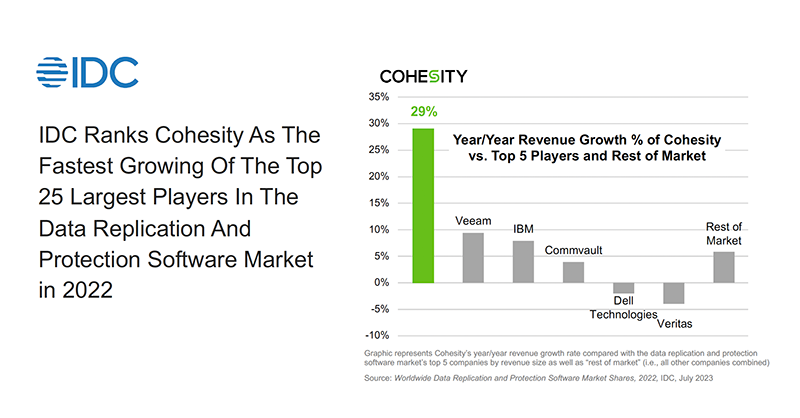Cohesity, a leader in data security and management, today announced the appointment of Eric Brown as Chief Financial Officer and Srinivasan Murari as Chief Development Officer.
Brown, who is an experienced public company CFO with over 25 years of proven operational experience and skills in helping companies scale, will manage Cohesity’s financial strategy as it expands its multicloud portfolio for data protection, redefines AI-powered data security and data management, and continues on the path to profitable long-term growth. His industry experiences include a range of enterprise technology markets, including security, data analytics, data management, collaboration, and interactive entertainment. In 2021, Brown led Informatica’s initial public offering as CFO, raising $1B in proceeds at a $10B enterprise value. Prior to that, he served in several public company CFO roles, including Electronic Arts, McAfee, and Polycom. Brown is a technology enthusiast, his passion dates back to his MIT days when he co-founded an AI/data mining company with his classmates.
Murari, who is a visionary technology executive with over 35 years of experience building world-class products and services in cloud and enterprise technologies, will be responsible for Cohesity’s engineering and R&D teams as they continue to innovate across AI, security, and multicloud. He most recently served as vice president of Engineering at Google Cloud, where he was responsible for the productivity of approximately 20,000 software engineers encompassing compute, storage, networking, security, databases, analytics, AI/ML, Kubernetes, serverless, cloud console, platforms, and fleet management. Before Google, Murari served as SVP of Engineering at VMware, leading teams across the company’s Storage and Availability, vSphere, and ESX portfolios, and brings deep experience in Compute and Storage across multicloud environments.
“The scale and growth Cohesity has achieved is a testament to the tremendous value its AI-powered data management and security innovations bring to organisations. My role is to ensure the company has the best financial framework for sustainable, profitable growth and leverage my experience to make Cohesity public company-ready,” said Brown. “I’m honoured to join Sanjay and the talented team he has put together as we continue on a course toward sustainable, profitable growth.”
“Cohesity is a phenomenal customer-focused company driven by ground breaking innovation, talented employees, strong leadership, and deep cultural values,” said Murari. “I am excited to work with Cohesity’s talented leadership team to continue to deliver industry-leading solutions that can help organisations radically simplify data management, improve their security postures in the face of sophisticated cyberattacks, provide AI-powered insights, and do more with data — their most valuable digital asset.”
These new appointments round out leadership changes made in June, expanding roles of key talent:
- Amith Nair, who has been pivotal in leading the company’s cloud initiatives, now leads the global marketing organisation as senior vice president of Marketing. He was previously in leadership roles at HashiCorp and Microsoft.
- Rebecca Adams, who has been serving as the CxO chief of staff, has taken on an expanded role as senior vice president of People & Places. She was previously in leadership roles at VMware.
- Elad Horn, group vice president of Product, now joins the executive team and reports directly to the CEO. He was previously in leadership roles at Proofpoint.
- Tonya Chin, who has been leading the Investor Relations function, has taken on an expanded role as group vice president, Corporate Communications and Investor Relations. She was previously in leadership roles at Nutanix.
These leadership changes mark the beginning of a significant milestone in Cohesity’s history, as the company has made a strategic shift in pursuit of a sustainable growth model that prioritises positive cash flow from operations. With this plan in place, the company expects to reach positive cash flow within Fiscal Year 2024 (August 1, 2023 – July 31, 2024) while preserving a healthy cash position.
“Cohesity’s business continues to be strong. Our industry-leading growth has been validated by the most influential industry analysts. We are growing in the enterprise and are significantly expanding our data security and Generative AI technologies while steadfastly advancing the number and depth of our strategic partnerships,” said Sanjay Poonen, CEO and President of Cohesity. “All of our key metrics indicate we are building a category leader with a focus on public readiness. We are taking share in our market by top-line growth while also aiming to become cash flow positive within our current fiscal year. Eric and Murari are well-respected talents in their areas of expertise who, along with our other leadership appointments, bolster our executive team to be one of the best in our category and position us well for our plans to become public.”
IDC ranks Cohesity as the fastest growing of the top 25 largest players in Data Replication and Protection Software Market in 2022
Cohesity has a unique position in a market with sustainable, high growth potential, as security, cloud, and AI have become mission-critical imperatives in nearly every board room and organisation. Industries worldwide must secure and manage data in a world of increasing cyberattacks, including ransomware. At the same time, business leaders require faster and deeper insights into data that helps them make better decisions.
According to IDC’s Semi-annual Software Tracker, Data Replication and Protection Software, Cohesity had the fastest worldwide year-over-year revenue growth among the Data Replication and Protection Software market’s top 25 largest competitors in calendar 2022.
Cohesity’s industry-leading growth is strong evidence that enterprise customers continue to select Cohesity over its competitors to replace legacy and point solutions. Today, eight of the top twenty banks in the U.S., six of the Fortune top ten, and 40 of the Fortune 100 have adopted Cohesity solutions.
